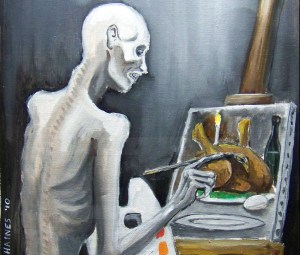Art, as many claim, is only art when it is universally admired.
In the Philippines, however, with an enlarging circle of individuals, whether of the elite or of the masses, conforming to an art spoiled and corrupted by superficial concepts, commercialism, and obsession on objectivism, what sort of art will impact the universe had the universe been wholly infested by this circle?
A universe conquered by men with a lowly regard for art on account of the perversion of media and commercialization is indomitably possible. Perhaps in this part of the world where the Philippines lies, it is, as manifested by the large contrast between the small crowd huddled in theaters in anticipation of a musical and sold out concerts of mainstream pop artists. There are the museums and the art galleries, rotting in abandonment, waiting to be unearthed for another school field trip. And how can we forget the bookstore shelves brimming with a disarray of paper backs of various love stories and magazines of various advertisements.
Had the Philippines been the universe, there is a chance that the arts contributed by the ancient Greco-Romans or even that of our own ancestors will be buried alive.
This is not to say that art can only be perceived from the form taken by classical artists. We have to consider that the mass arts have encroached into the grounds of our culture, as well, which is not the predicament. We used to have Bernal and Brocka for films. These artists have gained the right to be called artists in the rapidly revolving world of culture, arts, and technology, becoming themselves the revolution. Hence, it is not a matter of which form the art was created, rather what quality of art we have today in whichever form it takes. And by quality, what should be standard quality art?
Perhaps we can start appreciating art only when we eradicate its monetary value. This is exactly the reason why society does not take art much seriously as they do with science, business, and engineering. There is no financial gain in the arts. Anyone can be an artist. Any piece of art can be interpreted with profundity as long as such an interpretation can be presented. And even some of those whose names have become an eternal memory to the art industry, those that have served archetypes of their certain field of art, have only gained profit in their art works years after their death. However, living in a world where the prices of commodities have skyrocketed at a rapid rate and working two jobs is not enough, this does not preclude the idea of a life satiated by life’s aesthetic urges, exactly the reason why passion is rare.
Our educational system is mostly to blame. At our very young and vulnerable age, they have attempted to measure our knowledge for the arts through the accurate and precise way our knowledge for algebra was determined. It has led us to find mundane questions in our art exams such as “who made the painting,” “what is the title of the painting,” “when was the painting dated”, when form, content, and analysis of the painting, the most essential structures in appreciating a piece of art, were uncared for. The anti-intellectualism of subjectivism has led teachers and instructors to walk around classrooms like they were managers of budding money-making machines. Many then have neglected their passions and resigned to a life of labor, leading them astray not only from learning the value of the arts but also from knowing the value of their own genuine happiness.
As a form of media that could penetrate a wide heterogeneous group of audience, the mass arts are sending the wrong concept of art by merely giving us a series of movies and telenovelas revolving around superficial individual issues such as love, relationships, third parties, and the like at the cost of utmost amusement to the masses. In a world where the dividing line between arts and entertainment has been blurred, many have forgotten the significant contributions of art in the development of our world. Art has sparked the revolution against the Spaniards in the 1890’s, has given birth to the earliest civilizations, and has saved many a life for in the darkest of times we clasp on the hope of words, of mantras, of which we call poetry, of which we call art. It is essential to realize how art can affect us in a large scale in order that we deem it not only a source of entertainment, but mostly a source of knowledge, of societal development. With this mindset, the media might finally stop producing ruckus art and start giving us what, as a thinking audience, we truly deserve– a mind-challenging piece of art that would propel us to raise questions rather than simply give an answer.
The ignorance of the money-driven society cripples us from being in solidarity of appreciating the value of arts, half-satiating our aesthetic urges. Hence, mankind is a little more impoverished in the materialistic world he created.

